
The John A. Lafevre House and School is located along NY 208 in the town of Gardiner, New York, United States. It is often believed to be in New Paltz as it is within that town's ZIP Code. The house is a stone structure dating to 1772; the school was built in 1835 and remained in use for almost a century. Both are well-preserved examples of their type of building and were listed on the National Register of Historic Places in 1989.
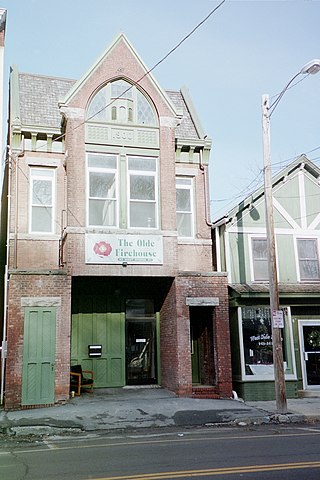
The Wiley Hose Company Building is located in Catskill, New York. The three story, brick building is a representative example of a turn-of-the-century firehouse. It was built in 1900 by George W. Holdridge, a local builder. The brick was produced in the Catskill area, and is complemented by stone and terra cotta detailing. The firehouse was altered somewhat around 1930 to accommodate the newer, larger mechanized fire equipment that replaced horse-drawn and smaller mechanized equipment. The matching entry porticos on either side were added at this time, and the wooden flooring in the equipment bay was replaced with concrete.

The Greenville Presbyterian Church is located on NY 32 just north of its intersection with NY 81 in Greenville, New York, United States. Its three buildings on two acres were listed on the National Register of Historic Places (NRHP) in 1985.
Leland Castle is a building in New Rochelle, New York. It was constructed during the years in 1855 - 1859 in the Gothic Revival style, and was the country residence of Simeon Leland, a wealthy New York City hotel proprietor. Leland began to assemble an estate as early as 1848, and in 1855, began the erection of this palatial 60-room mansion. The home was designed by New York City architect William Thomas Beers. A north and south wing were added to the castle in 1899 and 1902 respectively.

The Hebrew Congregation of Mountaindale Synagogue is located along Sullivan County Route 55 near the south end of the hamlet of Mountaindale, New York, United States. It is a small stucco building dating to 1917, expanded slightly in the 1930s. The interior is notable for its heavy use of marbleizing and other decorative touches. A 2009 traffic accident and fire caused some damage to the roof.

The Historic Walden United Methodist Church is located on West Main Street in Walden, New York, United States. It was desanctified in 2013 and sold by the congregation on November 24, 2014. The current location is at 1206 New York State Route 52, Walden, New York, United States. Ground was broken on a new House of Worship in September 2019 and was completed in 2022.

Agudas Achim Synagogue, formally known as Congregation Agudas Achim, is located on Rock Avenue in Livingston Manor, New York, United States. It is a stucco-sided wooden building erected in the 1920s to serve the growing Jewish community in that area of the Catskills. It served the large summer population of Jews from the New York area who vacationed at family resorts in the region.

The Glenville School is a historic school building at 449 Pemberwick Road in the Glenville section of Greenwich, Connecticut, United States. It was listed on the National Register of Historic Places in 2003. It was one of several schools built in the town in the 1920s, when it consolidated its former rural school districts into a modern school system, with modern buildings.

Congregation Bnai Israel Synagogue is located on Wagner Avenue in Fleischmanns, New York, United States. It is a wooden building dating to the *1920s, built two years after local farmers founded the congregation. Originally an Orthodox synagogue, it has since become Conservative. It is the only synagogue in the Catskills with an exposed truss roof. In 2002, the synagogue was added to the National Register of Historic Places, after a multi-year effort by Bernard Rosenberg, the descendant of a founding member. Congregation Bnai Israel Synagogue is the only synagogue in Delaware County to be listed.

Pakatakan Artists Colony Historic District is a national historic district located at Arkville in Delaware County, New York. The district contains 33 contributing buildings and two contributing structures built between 1886 and the 1960s. It consists of a small mountainside collection of studios and residences clustered about the original Pakatakan Lodge. It is an extremely well preserved collection of unusual Shingle Style and other wood frame seasonal buildings.

Indian Rock Schoolhouse, also known as District 3 Schoolhouse or Webutuck Country Schoolhouse, is located on Mygatt Road in the hamlet of Amenia, New York, United States. It is a wooden one-room schoolhouse built in the mid-19th century in accordance with a standard state plan for small rural schools that reflected contemporary educational reform movements.

The Brick Schoolhouse is a historic one-room schoolhouse at 432 New Hampshire Route 123 in Sharon, New Hampshire. Built in 1832, it is the only of the town's three such buildings to survive, and was the only one made of brick. It is also the only school building now standing in the town, since its students have been schooled in neighboring Peterborough since 1920. The building was listed on the National Register of Historic Places in 2002, and the New Hampshire State Register of Historic Places in 2001.

The Madison School, District No. 1 is a historic one-room district schoolhouse, located on the grounds of the Madison Elementary School on New Hampshire Route 113 in Madison, New Hampshire. The school was built in 1835, and continues to exhibit Greek Revival characteristics despite alterations in 1873 and 1951. It was used as a school until 1950, has hosted town meetings, and has served as the local library. It is presently home to the local historical society. The building was listed on the National Register of Historic Places in 1980, and the New Hampshire State Register of Historic Places in 2006.
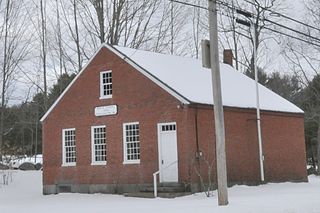
The North School, also known locally as the Brick School, is a historic one-room schoolhouse at 63 Amesbury Street in Kensington, New Hampshire, United States. Built in 1842, it was the only brick schoolhouse built in the town, and is one of its four surviving 19th-century schools. Of those, it is the best-preserved, and is used as a local history museum. It served the town's educational purposes between 1842 and 1956, and is now a local history museum. The building was listed on the National Register of Historic Places in 2013.

The District No. 9 Schoolhouse is a historic school building at 358 Hoyt Road in Gilford, New Hampshire. Built in 1815 and repeatedly altered to accommodated changing trends in school design, it is the best-preserved of Gilford's surviving district schoolhouses. Now a private summer residence, the building was listed on the National Register of Historic Places in 2000.
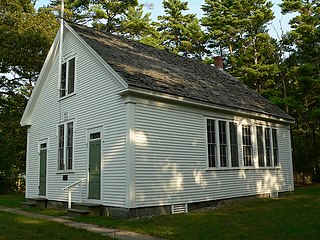
The Division No. 9 School is a historic former one-room schoolhouse on Maine State Route 9 in Wells, Maine. Built in 1900, it is the best-preserved of the town's surviving district school buildings, and is now a museum owned by the town. It was listed on the National Register of Historic Places in 1995.
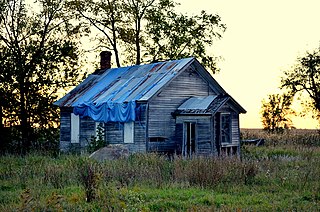
Wilson District No. 7 School, also known as the O'Meara Schoolhouse, is an historic structure located in rural Clinton County, Iowa, United States near the town of Delmar. The one-room school was listed on the National Register of Historic Places in 2004. The listing includes three structures: the former school building and two outhouses.
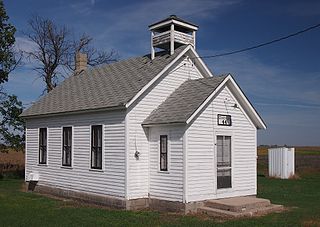
District No. 44 School is a historic one-room school in Taylor Township, Minnesota, United States. It was built in 1891 and used until 1954. The school building was listed on the National Register of Historic Places in 2011 for having local significance in the theme of education. It was nominated for being a well-preserved example of the one-room schoolhouses once common in rural Traverse County.

The West Berkshire School is a historic school building at Berkshire Center and Mineral Brook Roads in Berkshire, Vermont. Built about 1820, it is one of the state's oldest surviving two-room two-story schoolhouses. It was used as a school until 1970. It was listed on the National Register of Historic Places in 1993.

A two-room schoolhouse is a larger version of the one-room schoolhouse, with many of the same characteristics, providing the facility for primary and secondary education in a small community or rural area. While providing the same function as a contemporary primary school or secondary school building, a small multi-room school house is more similar to a one-room schoolhouse, both being architecturally very simple structures. While once very common in rural areas of many countries, one and two-room schools have largely been replaced although some are still operating. Having a second classroom allowed for two teachers to operate at the school, serving a larger number of schoolchildren and/or more grade levels. Architecturally, they could be slightly more complex, but were still usually very simple. In some areas, a two-room school indicated the village or town was more prosperous.





















